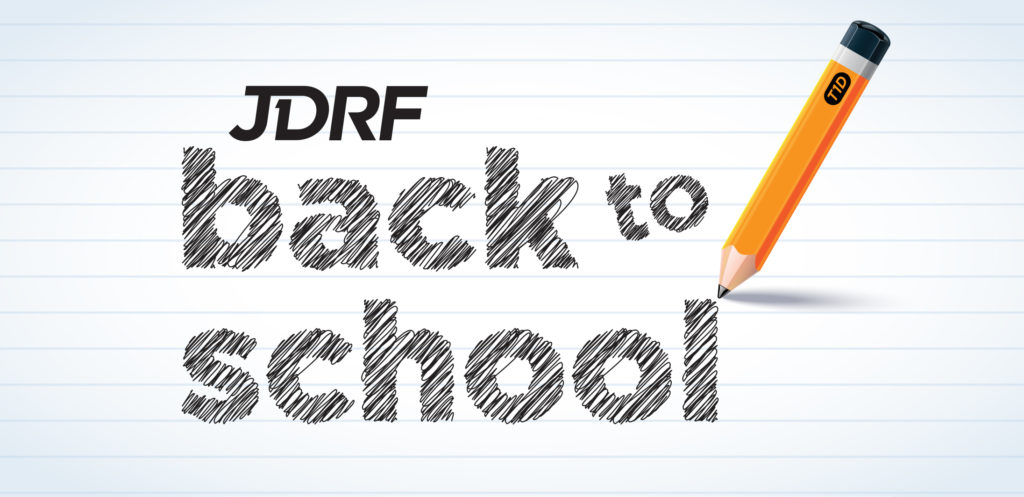How to pass back-to-school + T1D with flying colors

Back-to-school season can be an overwhelming time for students living with type 1 diabetes (T1D) and their parents/caregivers. It requires paperwork; special planning; and many conversations with teachers, nurses, and other students about T1D and how the disease is managed at school.
The good news is that there are many JDRF resources available for students with T1D at all grade levels:
K-12

Your child spends most of his or her day in the school setting—in the care of teachers, nurses, and other school personnel. Most parents are comfortable with this environment, as the average student’s healthcare needs consist of Band-Aids, oral medications, and the occasional ice pack. However, as a parent of a child with T1D knows, day-to-day disease management is intensive, and the school must play an important role in this care.
Here you can find some helpful tips for setting up a plan with your school that works for you and your child:
- Select the appropriate tools. Request the JDRF School Advisory Toolkit to find information for parents and educators about developing strong partnerships that give every child the best possible school experience. Click here learn more about coordinating care with your child’s school district from a local nurse with a son with T1D.
- Coordinate plans. Diabetes shouldn’t get in the way of school for people with T1D. Check out some helpful tips for setting up a Section 504 plan, building a school diabetes emergency kit, preparing your child’s Diabetes Medical Management Plan, and more.
- Empower teachers. Share information with teachers, so they have a better understanding of your child’s daily needs. Our 10 Things Teachers Should Know About T1D list provides a good overview of top topics. Don’t forget to educate your child’s coach!
- Educate classmates. JDRF offers kids many ways to educate, inspire, and motivate their peers to help make a world without T1D. These opportunities allow children, their schools, and communities to discover how volunteerism and support make a difference for kids living with T1D. And don’t underestimate the power of a diabuddy!
- Tailor approach for teens. Navigating the teenage years with T1D can be difficult. The JDRF Teen Toolkit can help parents and teens make the journey a little smoother.
- Join the conversation. Visit TypeOneNation.org 24 hours a day, 7 days a week, to exchange information, advice, and support on JDRF’s online resource community.
College
 It’s important to be aware that things change a bit at the college level. College is often the first time teens are away from home, and having T1D makes things more complicated. You and your college student can feel more prepared for the transition with the information and tips below:
It’s important to be aware that things change a bit at the college level. College is often the first time teens are away from home, and having T1D makes things more complicated. You and your college student can feel more prepared for the transition with the information and tips below:
- Register for accommodations. Inquire about special accommodations while exploring colleges with your teen in order to help guide his or her decision based on his or her specific needs. Once you begin the enrollment process you can work the school’s Disabilities Services office to complete the necessary paperwork. For instance, if your teen is living on campus, put in writing in your accommodation plan the need for nutritional data from food services.
- Check out The College Diabetes Network (CDN). CDN is a non-profit organization that provides young adults with T1D peer connections and expert resources in order to successfully manage the challenging transition to independence at college and beyond. You can search for CDN campus chapters here.
- Know your resources. JDRF recently partnered with CDN to create an Off to College Program, which offers resources for everyone involved; from printed booklets for students and their families, to informational toolkits for health clinics and diabetes organizations to host Off to College Events. Request a copy of the CDN guides for students and caregivers to help ease the transition from home to dorm.
- Check out Students With Diabetes (SWD). SWD is a peer and professional network for students and young adults living with diabetes. The organization aims to create a community for people with diabetes ages 18-30 on both college campuses and in local communities across the country. SWD equips young adults with the tools and information they need to succeed, as well as providing professional and social opportunities to create individual networks. You can search for a SWD chapter here.
- Continue the conversation. Our online forum is for everyone – all ages at all stages. You or your college student can connect with the T1D community 24/7 at TypeOneNation.org. Ask questions, offer support, and know you always have someone to reach out to who can provide first-hand tips learned through real-life experiences.
Above all, the most critical aspect of coordinating care with your child’s school district, college or university is communication. School personnel care about your child and want to do what’s best for him or her. Your child will thrive if he or she observes you and the school working in a cooperative, friendly, and mutually respectful manner. It’s up to you to educate, and we have the tools to help you!
_______________________________________________________________________________________________________________________

For further information or support with T1D in the school setting, please reach out to JDRF Eastern PA Outreach Manager, CarlaAnn Henry, at chenry@jdrf.org or 610-227-0361..